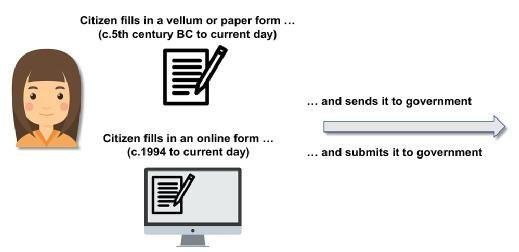
ryancslimakphoto - Fotolia
Escaping waterfall government and the myth of 'digital transformation'
An agile approach to digital programmes will not transform Whitehall unless the waterfall approach to policy and decision-making is overhauled too
Businesses such as Netflix, Flickr and Airbnb have changed the rules of the game by delivering improved services at lower cost via a radical transformation of existing business models. The UK government is hoping that its own attempts at digital transformation will now deliver equally radical improvements to our public services.
This desire to emulate the transformational gains delivered elsewhere comes as no surprise. Government faces growing budgetary pressures, increased public expectations and expanding demands on services. This, together with a host of other factors, from Brexit to an ageing population, has led government to seize upon “digital transformation” as its “get out of jail free card”. It promises the seemingly impossible – radically improved services at lower cost.
Despite a longstanding desire to use technology to improve public services – it has been a common cross-party aspiration for over 20 years – most digital transformation programmes end up lost in the weeds, endlessly re-designing and re-polishing websites. The result is usually a slightly better version of an existing process. Programmes automate and sometimes optimise services, but rarely re-engineer or transform them.
Updating websites will never deliver the new digital business models achieved by the likes of Netflix, Flickr and Airbnb. Radical changes of model – truly transformational thinking, such as replacing a permit with a tax, substituting satellite monitoring for field force inspections or shutting down a service or organisation – are not going to be delivered until government resets its approach.
| Objective |
Automation |
Optimisation |
Re-engineering |
Transformation |
| Change |
Changing the technology from manual to automated via the application of technology |
Improving applications by rationalising data structures and work processes |
Improving the organisation by redesigning data structures and work processes |
Improving services by re-designing legislation, policies, organisations, data structures, work processes, systems and services to achieve better outcomes |
| Summary |
Efficiency Doing the same things in the same ways but using technology to make it faster, cheaper or easier |
Rationalisation Doing the same things in slightly better and more efficient ways |
Effectiveness Doing the same things in notably better and simplified ways |
New business models Delivering substantially better, data-driven services, fundamentally redesigned and re-thought to centre on optimal user outcomes rather than existing organisational practices and priorities |
Table 1: Assessing the impact of technology
(Source: adapted from Reinventing government in the information age. Heeks, R (editor). Routledge, 1999)
The problem of waterfall government
Why is government trapped in this unproductive cycle? One reason is the sheer scale of the legacy business models in Whitehall. It stifles and smothers most attempts at innovation. Despite efforts to lift and shift the concept of the lean startup into the public sector, it was never designed for government and remains a poor fit.
Startups don’t have legislators and policymakers, or mandatory laws with statutory deadlines – or universal service obligations. Nor do they have the baggage of the infrastructure of government services and the deeply embedded machinery of the departments that operate them. The lean startup can pick and choose the market segments it wants to target, and when and how it releases its services – government cannot.
Similar problems have dogged attempts to parachute agile software development into government. For both agile and lean startups, the priority is keeping options open, letting the user inform and drive the design process. Yet this is a delusion in government. Agile teams usually find themselves working far downstream from where the real decisions are made about the delivery of policy objectives. Before they even start work, the design has already been constrained by legislation and policy, together with the existing department-centric business structures, processes and operations.
Agile window dressing
Without any input into the design of the business model, all that is left for most agile programmes is window dressing. Attempts at meaningful change find themselves boxed into working on a small part of the landscape. The teams chip away at what they can, each time using slightly better technology and approaches to user research, but fail to deliver what government desperately needs – deep transformation and radically different delivery models.
This leaves government in the holding pattern in which it has been stuck for more than 20 years, trapped within a narrow set of outcomes and reduced to simply improving its web presence. Grand promises are periodically made about “transformation”, but all that transpires is new shades of lipstick applied enthusiastically to the same geriatric and rather bored pig – over and over again.

Figure 1: The web has perpetuated the silos of form-based government
Agile is often caricatured as “making it up as you go”, and the alternatives as “making it up before you start”. This binary polarisation helps no one. If we want to explore and discover better delivery models, we need to do so before starting to build.
In practice, rushing into building “something, anything” at the back end of waterfall government achieves the opposite of what it intends – it blocks innovation. As soon as a team of web developers is hired, for example, the result is already guaranteed – a lovely new, award-winning website. So much for “making it up as you go”.
When “transformation” is handed to multiple user experience and development teams working within the existing boundaries of government, siloed technical and service solutions are the inevitable outcome. Each team will fail to grasp the bigger picture, and collectively they will fail to deliver transformation in its broader context. User- and developer-centric solutions only ever meet their own narrow domain needs. They may delight their subset of users, but they are guaranteed not to deliver radical transformation.
All of this plays into the hands of the reactionaries, frustrating those inside and outside the public sector who are working hard to make it better. True transformation threatens vested interests – it can enable budget cuts or even the entire removal of smaller agencies, departments and roles. It is convenient for institutionally conservative managers to watch the energy behind transformation dissipate harmlessly in the sandbox where the agile insurgents are left to play with their websites.

Figure 2: The limited scope of agile in government
To achieve digital transformation, government needs to implement a phase that is currently absent. It needs upfront fundamental reviews that return to first principles – “transformation bootcamps” that question and unlock upstream assumptions and designs. Such bootcamps could find better ways of delivering policy objectives, and work outside the silos of government’s existing structures and processes.
Government needs to root out new, technology-enabled business models of the kind seen in the private sector. This requires a radical rethink and redesign of existing approaches to policy, organisational structures and processes before rushing into delivery.
Transformation bootcamps
One of agile’s most valuable insights is the difficulty of separating design from implementation. But agile in the public sector works in isolation from the mass of designers we call “legislators” and “policymakers”. It doesn’t matter how many prototypes are user-tested on an agile programme – the most important design work happens outside their scope.
Imagine that the starting point for Airbnb had been the retention of all the policies and working practices of traditional hotels. If it had merely set out to improve their user experience, could it have delivered a disruptive new business model? Of course not.
Read more about government digital transformation
- It’s the business model, stupid – three steps to transform UK public services.
- By focusing on skills, collaboration and the citizen in its transformation strategy, government has set an ambitious plan for digital public services which deserves widespread support.
- Experts agree the government’s much anticipated transformation strategy is ambitious and on the right path, but needs strong leadership to be achieved.
It’s not waterfall project methods that are blocking digital transformation – it’s waterfall government. Legislation and policy are written in isolation from technology and delivery options. They are locked down early in the process and thrown over a wall at delivery teams working inside embedded organisational structures. Business processes are then created, with technology as a subservient afterthought.
If true “digital transformation” is ever going to happen, government needs to move away from this downstream, technically constrained approach. Success depends on redesigning legal, policy, process, usability and technology aspects as a single integrated model – while maintaining citizen focus.
Technology-enabled policy
Transformation bootcamps will deliver the deep exploration of new technology-enabled policy options that programmes currently bypass. They can draw upon legal, policy, operational and technology specialists from both inside and outside of government. They can include experts with knowledge of the way current policy is implemented, and experience of where the problems lie for users and officials.
The outcome will be proposals for entirely new approaches, along with options for the abolition of existing processes, services, organisations, systems and roles. They will not result in technical solutions that deliver only incremental improvements. Neither should they be conducted as a one-off exercise, but run as a series of continuing radical challenges to the status quo.

Figure 3: Developing new business models requires a much broader scope
This is not about a return to failed approaches – big bang complexity and the boiling of oceans. We should heed the lessons of what works – start small, map the landscape, gather data, explore options, work in the open, iterate ideas and let them grow. Transformational ideas should be tested with legislators, policymakers, technologists and users – gathering feedback and making improvements. That way, we can escape the false polarisation between “making it up as you go” and “making it up before you start”.
Delivering true transformation
Government needs to stop using “transformation” as a marketing slogan for timid, but over-hyped, efforts to automate and optimise services delivered via the web. Transformation requires a fundamental rethink of the way that technology and policy can together deliver government objectives. Agile programmes will only deliver their true potential when they are liberated from their current constraints at the back end of waterfall government.
A programme of rolling transformation bootcamps is a missing piece of the jigsaw. These will help government discover the alternative business models it has been seeking for decades. They offer a route to drawing the best of the private sector approach to technology into government.
The successes of Airbnb, Amazon and Netflix were premised upon ruthless questioning of how outcomes are best delivered. These companies rethought business models from scratch. Not one of them delivered digital transformation simply by launching a website to “better meet user needs”.
Conclusion
Twenty years of efforts to achieve “digital transformation” have delivered little beyond successive generations of award-winning websites. Supposedly “radical” approaches to transformation instead merely end up using technology to polish and optimise the current way of doing things. Recent efforts to slay the bogeyman of waterfall project management have unwittingly played into the hands of the conservative forces that reject transformation entirely, and left agile sidelined in a harmless sandpit.
It is not waterfall methods that have blocked digital transformation – it is waterfall government. The solution lies in returning to first principles and exploring new models for delivery of policy objectives – well before the recruitment of scrum teams diverts energies into the delivery of another website. Transformation bootcamps are an essential, missing piece of the jigsaw. Until they are put in place, government’s attempts at transformation will continue to apply colourful, but ultimately pointless, layers of lipstick.
 Jerry Fishenden is an independent technologist working with a range of clients. He has been CTO for Microsoft UK, the City of London financial regulator, the UK parliament and the National Health Service. He is also co-author of the business title “Digitizing government: understanding and implementing new digital business models”.
Jerry Fishenden is an independent technologist working with a range of clients. He has been CTO for Microsoft UK, the City of London financial regulator, the UK parliament and the National Health Service. He is also co-author of the business title “Digitizing government: understanding and implementing new digital business models”.

Cassian Young is an independent consultant specialising in digital strategy and digital transformation. He has worked for the Cabinet Office on a number of departmental transformation programmes.









